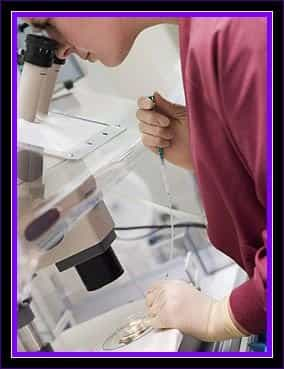Infertility due to ovarian malfunction

Anovulation and poly cystic ovary
What is Anovulation?
Anovulation means lack of ovulation, or absent ovulation. Ovulatory dysfunction is a common cause of female infertility, occurring in up to 40% of infertile women. Conception rates are in the normal population at around 20-30% per cycle and 80-90% after 12 months'
 What are the Symptoms of Anovulation?
What are the Symptoms of Anovulation?
Some women who do not ovulate experience irregular bleedings or spotting they misidentify as their period. This type of bleeding is slightly different in color and amount from normal menstruation, the bleeding is painless and irregular. This sign should point to Anovulation
Irregular period cycles are shorter than 21 days, or longer than 36 days, may have Anovulation. Anovulation means the hormones in the woman's body aren't quite right. These hormonal irregularities can sometimes lead to other issues, like lack of fertile cervical mucus, thinner or over thickening of the endometrium, abnormally low levels of progesterone, and a shorter luteal phase.
What Causes Anovulation?
The most common cause of ovulatory dysfunction is polycystic ovarian syndrome, PCOS.
Other potential causes:
- Obesity
- Too low body weight
- Extreme exercise
- Hyperprolactinemia
- Premature ovarian failure
- Low ovarian reserves
- Thyroid dysfunction
- Extremely high levels of stress
How is Anovulation Diagnosed?
- Basal Body Temperature Charting
- Day 21 progesterone blood test. After ovulation, progesterone levels rise. If progesterone levels do not rise,it is Anovulation.
- Ultrasound to track follicle development and ovulation.

What are the causes for ovarian malfunctions?
-Causes suitable for ovulation induction
Hypogonadotrophic hypogonadism means failure of the pituitary gland to produce luteinising hormone and follicle stimulating hormone. the concentrations of luteinising hormone, follicle stimulating hormone, and estradiol will be low.
Hyperprolactinaemia leads to a reduction in the production of pituitary luteinising hormone and follicle stimulating hormone. A microadenoma is easily treated with drugs with a subsequent resumption of menses and fertility.
Hypothalmic-pituitary-ovarian axis (FSH=follicle stimulating hormone; GnRH=gonadotrophin releasing hormone; LH=luteinising hormone) disorders are main cause of infertility.
Ovarian causes
Polycystic ovary syndrome is the commonest cause (70%) of anovulatory infertility. The primary abnormality seems to be an excess of androgen production within the ovary that leads to the large numbers of small preovulatory follicles, which fail to respond to normal concentrations of follicle stimulating hormone. Thus, a dominant follicle is rarely produced. Women with polycystic ovary syndrome commonly present in their late teens or early 20s with hirsutism, acne, or irregular periods (cycle length > 35 days). Even if they ovulate, the chance of conception for these women is reduced. Obese women with polycystic ovary syndrome have anovulation.? (PCOD is described in much detail below).
-Causes unsuitable for ovulation induction
Premature ovarian failure (premature menopause)
Unfortunately this is an irreversible condition. The only treatment option that can result in conception is the use of donated eggs with in vitro fertilisation. Patients will need hormone replacement therapy to support pregnancy.
Genetic abnormalities
The commonest genetic abnormality is Turner's syndrome (45,X), in which underdeveloped (streak) ovaries result in primary ovarian failure (premature menopause
Ten per cent of primary amenorrhoea is caused by testicular feminization - intra-abdominal gonads that are testes instead of ovary.

Management of Anovulation
What are the Potential Treatments for Anovulation?
Many of the treatments are simple and effective, However, not all causes of anovulation are amenable to treatment by ovulation induction. It is the cause of the anovulation that will determine whether ovulation induction is possible. Some cases of anovulation can be treated by lifestyle change or diet
If the cause of anovulation is premature ovarian failure, or low ovarian reserves, then fertility drugs are less likely to work.
Change of weight
Women with polycystic ovary syndrome who are overweight (body mass index > 30) should be advised to lose weight. Together with exercise, weight loss (even as little as 5% of body mass) reduces insulin and free testosterone levels, resulting in improved menstrual regularity, ovulation, and pregnancy rates. If a woman is obese when she is pregnant she is more likely to miscarry. Women who are underweight (body mass index < 20) should be encouraged to gain weight, and no infertility treatment should be offered until their body mass has returned to the lower limits of normal.
Hyperprolactinaemia
Bromocriptine is safe and commonly used. Cabergoline and quinagolide are newer long acting dopamine agonists with fewer side effects. Once prolactin levels have returned to below 1000 IU/l the woman's periods should return and 70-80% of women will ovulate.
Hypothyroidism
Correction of the hypothyroidism with thyroxine replacement allows thyroid stimulating hormone and prolactin levels to return to normal, releasing the suppression to gonadotrophin secretion and ovulation.?
 Medical induction
Medical induction
Pulsatile gonadotrophin releasing hormone
Treatment with gonadotrophin releasing hormone for a purely hypothalamic cause of amenorrhoea, for example women with recovered weight related amenorrhoea but who are still not ovulating. The woman wears a small mechanical syringe pump that can deliver a pulse of gonadotrophin releasing hormone subcutaneously every 90 minutes, and this usually leads to unifollicular ovulation. Local reactions may occur at the injection site.
Antioestrogen treatment: Clomifene
Usually, Clomifene is the first fertility drug tried. Clomifene can trigger ovulation in 80% of anovulatory women, with a conception rate of 40-60% at six months.
Clomifene acts by blocking oestrogen receptors in the pituitary which leads to an increased production of follicle stimulating hormone, which then stimulates development of one or more ovarian follicles. These drugs should be used only when the hypothalamic-pituitary axis is functioning—for example, polycystic ovary syndrome.
Premature ovarian failure with an elevated FSH, and women with extremely low estrogen levels fail to respond to Clomiphene. Occasionally, patients develop multiple cysts with the use of clomiphene citrate.
Metformin
Metformin at doses of 1500 mg a day may improve menstrual regularity by reducing insulin and free testosterone concentrations in polycystic ovary syndrome who are not ovulating
Follicle stimulating hormone injections
Treatment with follicle stimulating hormone is used in women with hypothalamic-pituitary causes of anovulation.
Surgical induction
Laparoscopic ovarian drilling can be done in women with polycystic ovary syndrome. At laparoscopy, five to six diathermy or laser punctures are made in the ovary. Complications can arise from surgery and intra pelvic adhesion can occur. If too much ovarian tissue is destroyed there is a potential risk of premature ovarian failure can occur.
Treatment by Homeopathy for ovarian malfunctions causing infertility
Firstly it should be remembered that Homoeopathy is a specific and unique form of medicinal treatment, which does not include and has nothing in common with modalities with other systems of medicines such as Acupuncture, Herbal Medicine - whether traditional, western or Chinese, Ayurvedic medicine, aromatherapy, etc.
Since homeopathy is meant to treat the whole person, it affects the reproductive organs surely to bring its original functions for which those organs are meant for. Homeopathy will create conditions favorable to reproduction, since this is what those organs are meant to do. This fact is well known among all elite people. I have many stories of making babies in difficult cases of infertile women around the world."
Treatment is aimed at the specific patient and it is rare for two patients to receive the same treatment for infertility. Individualization of homeopathic treatment, tailored to address the infertility problems as it manifests in the individual patient determines the level of success in many instances.
Homeopathic infertility treatment stretches across about four months, but can be much longer, depending on complications and previous infertility treatment interventions.
The total cost of homeopathic infertility treatment is a fraction of conventional infertility treatment and without any negative damaging side-effects. The total cost will often amount to less than 15% of a single AI or IVF.
Studies comparing homeopathy's effectiveness in treating infertility showed that homeopathy had the same success rate as Western allopathic fertility treatments but at a fraction of the cost ($3,000 for homeopathy as compared to $30,000+)
Homeopathy is used most best in North America. 70% of homeopathy patients are women receiving treatment for women's issues (PMS, menopause, infertility, pregnancy, labour support, cysts, fibroids and menstrual irregularities).
Folliculinum is a good homeopathic remedy that can stimulate ovulation in women who have poor ovarian reserves. If a woman is not ovulating this remedy when taken before ovulation will stimulate the release of the egg into the ovary. This remedy is suitable in treating cases of PCOS.
As far as homeopathic remedies for blocked Fallopian tubes, it all depends on the reason for the blockage. These are a number of remedies that can help if the Fallopian tube is blocked due to scarring. thiosinaminum 6X taken daily for three months is the best treatment. If the blockage is due to mucus filled debris, Pulsatilla, Sepia, Medorrhinum, Tuberculinum, and Thuja can be suitable.
Another important remedy to consider is Borax for blockage related to candida overgrowth.
It is recommend the following homeopathic remedies for a total of 4 months period:
Folliculinum 200CH on day 10 of the menstrual cycle
Thuja 200C on day 14 of the menstrual cycle
Borax 30CH from day 8 to 16
Pulsatilla 12CH every morning
Sepia 6CH every evening
Natrum muriaticum 30CH on day 7, 14, 21
For more information about Infertility/IVF treatments visit PlacidWay, a leading US-based medical tourism resource and provider.



.png)

.png)

